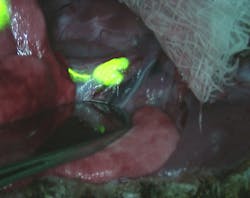A collaborative effort from researchers at the Harvard School of Public Health (Boston, MA), Beth Israel Deaconess Medical Center (also in Boston), Massachusetts Institute of Technology (Cambridge, MA), and the German Research Center for Environmental Health (Neuherberg/Munich, Germany) using fluorescence imaging has resulted in a better understanding of the movement of potentially toxic—but potentially life-saving as well—nanoparticles within the body of a rat.
Using an intraoperative near-infrared fluorescence-imaging technique called fluorescence-assisted resection and exploration (FLARE), which simultaneously acquires 700 nm and 800 nm fluorescence images and color video images in real time, the researchers experimented using nanoparticles with a variety of diameters (up to 300 nm), shapes, and surface charges. The FLARE images revealed that inhaled nanoparticles smaller than 34 nm in diameter move from the lungs to the lymph nodes in as fast as 30 minutes, with even faster movement (a few minutes) for smaller particles. These smaller particles are also impacted by surface charge and can move quickly into the kidneys and bloodstream before being released in urine in as little as one hour from inhalation. The study has important implications for drug delivery and carcinogenesis, as nanoparticles could be optimized based on an understanding of where and how long they congregate in specific areas of the body. Contact Akira Tsuda at [email protected].

